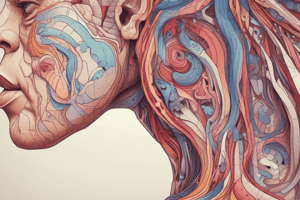Podcast
Questions and Answers
Which function is primarily associated with sebaceous glands in the skin?
Which function is primarily associated with sebaceous glands in the skin?
- Producing sebum to lubricate skin and hair (correct)
- Regulating body temperature through sweat secretion
- Facilitating the process of keratinization
- Creating a barrier against external pathogens
What is the primary difference between thick and thin skin?
What is the primary difference between thick and thin skin?
- Thick skin contains more hair follicles than thin skin
- Thin skin is generally found on the palms and soles of the feet
- Thick skin lacks a stratum corneum compared to thin skin
- Thin skin has a higher concentration of sebaceous glands (correct)
Which of the following components is least related to the structure and function of hair?
Which of the following components is least related to the structure and function of hair?
- Hair matrix cells
- Eccrine sweat glands (correct)
- Melanocytes
- Sebaceous glands
What is the primary role of melanocytes in the skin?
What is the primary role of melanocytes in the skin?
Which process describes the transformation of epidermal cells as they migrate from the basal layer to the skin surface?
Which process describes the transformation of epidermal cells as they migrate from the basal layer to the skin surface?
Flashcards
Hair matrix cells
Hair matrix cells
Hair matrix cells are responsible for producing the keratin that forms the hair shaft. These cells divide rapidly and push older cells upwards, leading to hair growth.
Melanocytes and Melanosomes
Melanocytes and Melanosomes
Melanocytes are specialized cells found in the skin that produce melanin, the pigment responsible for skin and hair color. Melanosomes are small organelles within melanocytes that package and transport melanin.
Sebaceous glands
Sebaceous glands
Sebaceous glands are small, sac-like glands located in the skin that produce sebum, an oily substance that helps lubricate and protect the skin and hair.
Eccrine sweat glands
Eccrine sweat glands
Signup and view all the flashcards
Fingernail Growth
Fingernail Growth
Signup and view all the flashcards
Study Notes
Integumentary System
- The integumentary system functions as a barrier, protecting against environmental factors.
- Hair matrix cells produce hair.
- Melanocytes produce melanin, which gives skin its color. Melanosomes package and transfer melanin.
- Sebaceous glands secrete sebum, a lubricating substance.
- Eccrine sweat glands (merocrine) are involved in thermoregulation.
- Parts of hair include the cuticle, cortex, medulla. Hair follicles have specific layers.
- Pilosebaceous units are a combination of hair follicles and sebaceous glands.
- Fingernails are composed of keratin and grow from a nail matrix.
- Skin is categorized as thick or thin skin, with differences in structure and function. Sebaceous glands are present in thick skin, but not uniformly distributed in thin.
Skin Structure and Function
- Skin is composed of various tissues, including epidermis, dermis, and hypodermis.
- Tissues like tendons and the dermis are components of the integumentary system, not the other way around.
- Cell connections, like gap junctions (cytoplasmic channels), and tight junctions (impermeable barriers), are present in the integument. Specific proteins mediate these functions.
- Bone tissue is differentiated. Compact bone is dense, while spongy bone is porous.
Keratinization
- Keratinization is a process where epidermal cells become hardened with keratin, forming a protective layer.
Skin Components and their Functions
- Sweat glands regulate body temperature.
- Sebaceous glands secrete sebum for lubrication.
Studying That Suits You
Use AI to generate personalized quizzes and flashcards to suit your learning preferences.




